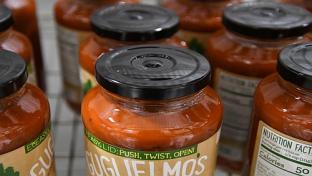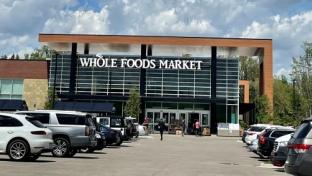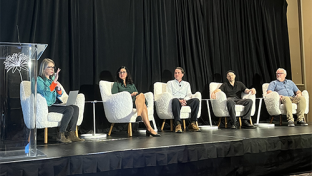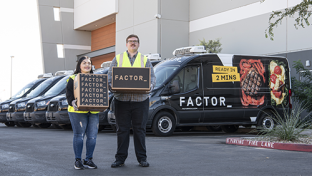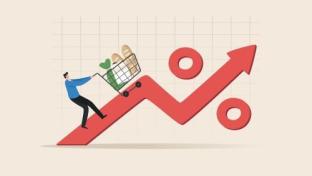SPECIAL REPORT: The Latest Food Packaging Innovations
More Packaging Coverage
In response to consumer concerns about the environment, suppliers and retailers are adopting more earth-friendly packaging options. According to research from global management consulting company McKinsey & Co., 43% of consumers believe that environmental impact is an extremely or very important packaging characteristic when making purchasing decisions, so the move to sustainable packaging makes sense.
First, though, it may be helpful to define the term, “as there are many different ways to be ‘sustainable,’” observes packaging business expert David Marinac. “Using less packaging; using a different type of material, such as biodegradable or 100% recyclable; and the most common attempt — companies using ‘refills,’ [meaning they] sell a rigid container once, and then sell refills using flexible packaging.”
[Read more: "How Consumers Are Driving Packaging Changes"]
In regard to that last solution type, “We’re seeing a lot of brands giving thought to how packaging can be designed to be reused, repurposed or even made into a collectable item, so it stays in someone’s home,” notes Michael Duffy, global creative director at Equator Design, a global packaging design agency with its headquarters in the U.K. city of Manchester.
An example Duffy gives is that of West Palm Beach, Fla.-based ASR Group, which “reduced the use of plastic in their Easy Baking Tub by 28% for their Domino Sugar and C&H Sugar brands by moving from a round to a square package. The tub is recyclable and reusable, so shoppers are encouraged to refill the package once it’s empty, using the Domino Sugar or C&H Sugar sold in bags. As well as adding the How2Recycle label to the pack, ASR Group are collaborating with influencers and using social media to get the word out about the containers’ reusability.”
Duffy also sees the potential for retailers to tout their eco-friendly bona fides through packaging. “At a store level, retailers can make use of creative POS displays to ensure their sustainability credentials are conveyed effectively,” he suggests. “Point of sale can be one of the most valuable touchpoints for communicating values, and shoppers are looking for retailers that share theirs. It’s all about increasing visibility. Or, like ASR Group, they could engage in social media campaigns and influencer marketing to get sustainability messaging out there. Creating product transparency and traceability is also important, and packaging can be used to convey this.”
“Overall, consumers are looking for more sustainable options at the shelf,” affirms Alexis Guetzlaff, director of marketing-food and NAB, AMN at Perrysburg, Ill.-based Owens-Illinois (O-I), a glass container manufacturing company. “This might be anything from looking for ingredients that are grown responsibly to packaging with lower negative impact on the environment.”
Not surprisingly, O-I recommends glass as an optimal packaging solution in this regard. Guetzlaff points out that it’s “made from natural ingredients — including recycled glass — and infinitely recyclable. With this strong sustainability story, glass is a great substrate choice for products that would like to show up sustainably at the shelf.”
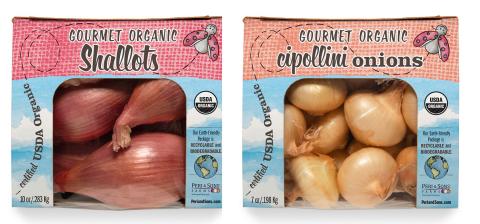
Produce Packaging Problems
For one industry, though, sustainability is particularly difficult to attain.
“It’s hard to avoid hearing the roar of the sustainability train,” admits Teri Gibson, director of marketing at Yerington, Nev.-based Peri & Sons Farms, a grower, packer and shipper of premium white, yellow, red, sweet and organic onions. “Get onboard or get run over. I think all of us in the produce industry are climbing aboard as fast as we can, but the onboarding process is riddled with challenges.”
Those challenges include “how to package our line of fresh onions sustainably, without compromising the sustainability of our farming business,” notes Gibson. “After all, if there’s no profit, then there’s no taking care of people and planet. Solutions need to be sustainable.” She also cites affordability, no clear eco standards in the United States, and a lack of raw sustainable materials worldwide as barriers preventing produce companies from easily transitioning to earth-friendly non-plastic packaging.
“Decades of producing oil-based packaging materials has created economies of scale that are highly productive, efficient and profitable,” Gibson points out. “This massive infrastructure is entrenched and not easily moved. It will be a while before companies can efficiently produce competitively priced non-plastic packaging materials.”
Meanwhile, she observes that “[o]ur packaging team is diligently exploring and testing new sustainable packaging options. For us, any new options must work with the packaging equipment we’re already invested in; keep the product fresh; be strong enough to withstand packing, shipping and merchandising; provide food safety; be visually appealing; be either plastic free, single-stream recyclable, biodegradable and/or compostable; and … must be affordable.”
Despite the obstacles, Peri & Sons has seen success with Earthpak, an all-paper eco-friendly package solution from Sev-Rend. “It’s 100% plastic-free [and] biodegradable/compostable,” explains Gibson. “This product is being well received, and we hope that retailers will continue to see the value of paying and charging a little more for this option. We have also been able to produce biodegradable clamshells with Warren Packaging for our organic shallots, cipollinis and shallots. It’s a small-scale program, but organic specialty products like these have a better chance of recouping the added cost at retail.”
[Read more: "How Retailers Can Boost Their Private Label Packaging"]
She adds: “While we look for more sustainable packaging options, we are still making process improvements, such as eliminating fingerholds along the edge of a consumer onion package, that reduce the amount of material being used. Every minute we produce these packages, we’re saving 36 square feet of material. That’s over 33,000 square feet per day of waste. That’s a little change making a big difference.”
Even with such challenges for produce and other categories, “I think overall we will continue to see innovation related to improved sustainability of packaging,” predicts O-I’s Guetzlaff. “Packaging that keeps food from spoiling and avoids waste is a key component in a sustainable food and beverage system. So, to keep improving our products and reducing the impact packaging has on the environment will be key to success.”
In Duffy’s opinion, carbon labeling, which can help shoppers quantify the environmental impact of their purchases, “will be an interesting one to watch. It often comes under criticism because there isn’t a standardized system of quantification, rating or labeling yet, but it’s thought that the widespread adoption of carbon labeling could lead to the eventual harmonization of criteria and an agreed standard for how this information is displayed on pack.”
He also expects “more transparency on the ‘nonrecyclability’ of packaging, noting the components of packs that are not widely recyclable, [and so] alleviating confusion and ensuring waste streams are clean.”
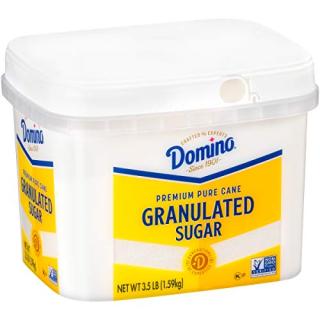
Don’t Forget Functionality and Convenience
However sustainable it is, packaging must still perform well and make life simpler — no one wants a leaky or hard-to-open carton.
“When it comes to functionality, I think one of the most interesting trends is the growth of universal design — designing inclusively and with the needs of people/users with a disability front of mind,” says Equator Design’s Duffy. “What’s great about this is, when you approach packaging design — or any type of design — this way, you often end up creating an end product that benefits everyone. Easy-open packaging is a great example: It doesn’t have any plastic wrapping or twist ties. Instead, it has elements like loops that can be pulled with one hand to pop the packaging open. Not only have you forfeited plastic in this instance, you’ve created something that’s a dream to open, whether you’re disabled or not.”
Duffy goes on to mention the NaviLens code and app, which he describes as “an absolute game-changer for blind consumer inclusivity. Kellogg’s has utilized this transformational technology on its cereal boxes, which can be detected significant distances away in a fraction of the time, not only helping the consumer locate the item itself, but [also] get key information, such as allergy warnings or recycling instructions, in spoken form. It can also pick up product information that is blurred or presented at acute angles, which is truly incredible. NaviLens is an exceptional example of how brands can put accessibility at the forefront of design and packaging decisions to become a true catalyst for change.”
One trending feature of packaging facilitates preparation of the product inside.
“‘Cook-in’ or ‘crisping’ trays are not only innovative ways to crisp, steam or bake products in a microwave or conventional oven, they’re also the primary packaging at shelf,” notes Peter Boosalis, VP of business development at Sussex, Wis.-based global marketing experience company Quad. “They’re based on the same theory as steam bags for vegetables, which, as the primary package, not only market the product on the frozen shelf, but also serve as a convenient vehicle for cooking the food in the microwave. Embedding crisping substrates and designing in steam-release venting enhance functionality because they mean the primary packaging itself improves cooked-product performance.”
Continues Boosalis: “There are a lot of innovations in this space. Think about products, like pre-seasoned proteins, that you prepare in the same wrapper that they come in, or snack bowls for on-the-go or hand-held pizza items, which use a crisping barrier in the microwavable primary packaging. These package designs are highly convenient for cooking, and the user can simply recycle or throw away the cooking vehicle, which is also the primary packaging. There’s little to no mess, and no dishes to wash.”
Although he concedes that “of course, there are concerns about sustainability” with these types of solutions, he’s also quick to point out that “often, there are fewer materials needed for these food packages, and many of the substrates are recyclable.”
When asked about future developments in the functionality and convenience space — including forthcoming solutions’ eco-friendliness — Boosalis replies: “Look for even more innovation where the packaging makes preparing food in the microwave, oven or stovetop an experience that’s clean, quick and easy. Recycling will continue to improve, alongside more and more options for sustainable packaging, including using less material for smart food prep. The U.S. tends to look to the U.K. for package and food prep innovations, so watch our friends in Europe for the latest in quick, easy and high-quality food prep concepts.”
Packaging business expert Marinac also weighs in on that last point, noting that “many packaging styles and materials have been in use successfully in the U.K., Australia and New Zealand for five years or more before the U.S. market has even noticed.”
Additionally, e-commerce is giving rise to new conceptual approaches.
“The continued charge of online shopping is putting new demands on packaging and, as a result, pack design will need to be specifically tailored to it,” observes Duffy. “Unboxing at home will become more prevalent, so brands and retailers need to get an effective grip on this to support the customer experience and their engagement with the product when consumers are not purchasing in a physical store.”
One interesting packaging trend that Michael Duffy, global creative director at Equator Design, a global packaging design agency with its headquarters in the U.K. city of Manchester, has noted is the increasing use of QR codes.
“Brands are increasingly taking it upon themselves to educate and assist customers on how to properly dispose of packaging,” observes Duffy. “The use of labels and symbols is growing, creating an increasingly noisy landscape and potentially confusing people, so the best approach for brands is to provide actionable end-of-use information via a QR code with a clear call to action alongside it. … [I]n the U.S., there is a vast array of labels, consisting of a mix of third-party and brand-/retailer-owned initiatives, perhaps owing to a lack of regulation, which leads to ambivalence and confusion. It’s far more convenient to use a clear instruction next to an easily scannable code.”
Going forward, he believes that “QR codes are likely to feature not just on front of packs, but also within the pack itself, allowing brands/retailers to tap into local programs, including disposal information that is accurate for all consumer demographics.”
For his part, packaging business expert David Marinac points out that “QR codes can not only be personalized (with a personalized message or story of why the product is so great), but more important, [they] can have important details about the date of manufacture, the lot number, who the operator was that made it, etc. — all critical details for food safety and retail compliance.”




